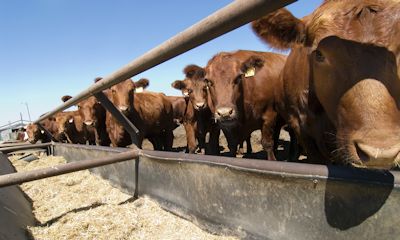
Historically, when grain prices get high, there's more interest among feedlot producers in feeding silage. But what about right now, when corn prices are low? This year, with $3.50 corn, or about 9 cents per pound of total digestible nutrients (TDN), silage, at 75% TDN is the cheapest source of TDN.
Galen Erickson, University of Nebraska-Lincoln professor and Extension beef feedlot specialist, addressed the topic at recent UNL Beef Feedlot Roundtables.

COUNTING THE COSTS: Research has shown that with more silage and less corn in the ration, cattle become less efficient. But it's also been shown that even as conversion curves downward, profitability goes up. Even with $3.50 corn, feeding silage can be profitable, with a few key considerations, says Galen Erickson.
"I think at today's prices it's probably a good idea for some smaller operations to consider even more than traditional amounts," says Erickson. "It beats other alternative forages. You don't have to further process it like you do hay and it's a guaranteed one-time inventory."
Since the 1960s, research has shown that with more silage and less corn in the diet, cattle become less efficient. But it's also shown that even as conversion curves downward, profitability goes up. Even with $3.50 corn, feeding silage can be profitable, with a few key considerations, Erickson says.
Where's the value?
One of these is how silage is priced. Many growers assume the value of silage is equal to the value of corn delivered to market. If you harvest corn for silage, you don't have to combine it or transport it to market – especially if you're a cattle producer raising your own corn, the distance to market is pretty short.

There's a cost of about $32 per acre to harvest corn, along with a $22 per acre cost to haul that corn to market. "I never appreciated if you put up silage, you don't have to combine corn and also have to transport it to market," Erickson says. "There's a $50 per acre savings just by cutting silage instead of harvesting."
While there is a nutrient value removed with the silage – about $49.70 per acre worth of nitrogen and phosphorus in a 200-bushel corn crop – the savings from not having to harvest and haul the grain offsets these costs. However, if the operation is integrated there's an opportunity to recycle those nutrients through manure, and silage presents a bigger apply that manure, mitigating the costs associated with nutrient removal.
~~~PAGE_BREAK_HERE~~~
While there is a nutrient value removed with the silage – about $49.70 per acre worth of nitrogen and phosphorus in a 200-bushel corn crop – the savings from not having to harvest and haul the grain offsets these costs. However, if the operation is integrated there's an opportunity to recycle those nutrients through manure, and silage presents a bigger apply that manure, mitigating the costs associated with nutrient removal.
A big factor is the cost per ton of dry matter, and the amount of TDN, or energy. If the farmer was harvesting 200-bushel corn, that's about 4.76 tons per acre of dry matter in the grain at harvest. At $3 per bushel, that's roughly $126 per ton of dry matter. At 52% grain, there are about 9.15 tons of silage dry matter per acre. Assuming the value of the corn is $600 per acre, that's a cost of $65.54 per ton. Accounting for 35% dry matter, the cost is about $22.94 per ton – regardless of the corn price, the value of silage is typically 7.65 times the price of corn per bushel when standing in the field, assuming there is no yield drag.

Once shrink is factored in, along with the cost of harvesting, hauling, packing and storage, the price can be 10 to 13 times the price of corn. There also appears to be a 10% to 15% yield drag on corn grain at the time of silage harvest, which has to be adjusted when pricing on a per acre basis. A tool is being developed to help with pricing of corn silage, which will be released at an upcoming silage conference in June.
When to harvest
Silage profitability may increase with higher inclusion levels and with higher dry matter, as cost should be lower although performance isn't always as good. So, when's the best time to harvest silage? "You've got to look at the corn field and judge: when is the best time to harvest silage? And that's tough," Erickson says.
Milk line can be used as a predictor of silage maturity. Black layer is 100% mature, and harvesting at that point ensures no grain loss. Harvesting at three-quarters milk line means about 36% to 37% dry matter. However, with dry matter at 40% or higher, there's potential for more profitability, Erickson notes.
Another thing to consider is how much silage is included in the ration – as more silage is included, cattle get less efficient. However, Erickson notes when the studies were conducted in the 1960s and 1970s outlining the efficiency of beef cattle on silage diets, distillers grains were not yet common. "Maybe combining silage with distillers grains is a better fit than just feeding more silage," he says. "If we feed silage with distillers grains, there's a good synergy between the two, especially from a protein standpoint."
About the Author(s)
You May Also Like






